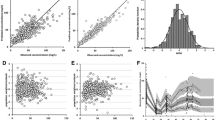Abstract
Purpose
Bevacizumab (BV) prolongs the survival of colorectal cancer patients when combined with irinotecan (CPT-11)-based regimens. In the AVF2107g study, the area under the curve (AUC) ratio for bolus CPT-11/5-fluorouracil (5-FU)/leucovorin (LV) (IFL) with the BV arm to bolus IFL with placebo indicated that SN-38 concentrations may have been increased in subjects receiving BV. However, the mechanism underlying such increase remains unclear, and the difference might be caused by an imbalance between the two arms and a possible inter-subject variability of CPT-11 metabolism. Within-subject comparisons were used to evaluate the effect of BV on advanced colorectal cancer patients when administered with the FOLFIRI regimen as second-line chemotherapy.
Methods
Ten advanced colorectal cancer patients received the FOLFIRI regimen every 2 weeks. At cycle 1, BV was administered following FOLFIRI administration to allow baseline pharmacokinetic (PK) analysis of CPT-11 and its metabolites. From cycle 2, BV was administered just before FOLFIRI administration. Plasma samples were collected under the same condition (at cycle 3).
Results
There were no significant differences in the C max and AUC0-∞ of CPT-11, SN-38, and SN-38G between cycle 1 (without BV) and cycle 3 (with BV). PK parameters of CPT-11, SN-38, and SN-38G were not significantly affected by BV. There were no significant differences in the changes in the AUC ratio of CPT-11 to SN-38 between cycles 1 and 3, as well as in the ratio of SN-38 to SN-38G.
Conclusion
BV does not affect the plasma concentration of CPT-11 and its metabolites on FOLFIRI regimen.




Similar content being viewed by others
References
Ferrara N, Gerber HP, LeCouter J (2003) The biology of VEGF and its receptors. Nat Med 9(6):669–676
Hurwitz H, Fehrenbacher L, Novotny W et al (2004) Bevacizumab plus irinotecan, fluorouracil, and leucovorin for metastatic colorectal cancer. N Engl J Med 350(23):2335–2342
Fuchs CS, Marshall J, Barrueco J (2008) Randomized, controlled trial of irinotecan plus infusional, bolus, or oral fluoropyrimidines in first-line treatment of metastatic colorectal cancer: updated results from the BICC-C study. J Clin Oncol 26(4):689–690
Slatter JG, Su P, Sams JP et al (1997) Bioactivation of the anticancer agent CPT-11 to SN-38 by human hepatic microsomal carboxylesterases and the in vitro assessment of potential drug interactions. Drug Metab Dispos 25:1157–1164
Guichard S, Terrat C, Hennebelle I et al (1999) CPT-11 converting carboxylesterase and topoisomerase I activities in tumor and normal colon and liver tissues. Br J Cancer 80:364–370
Iyer L, Hall D, Das S et al (1999) Phenotype-genotype correlation of in vitro SN-38 (active metabolite of irinotecan) and bilirubin glucuronidation in human liver tissue with UGT1A1 promoter polymorphism. Clin Pharmacol Ther 65:576–582
AVASTIN (2007) (package insert) Genentech, Inc, South San Francisco
Kurita A, Kaneda N (1999) High-performance liquid chromatographic method for the simultaneous determination of the camptothecin derivative irinotecan hydrochloride, CPT-11, and its metabolites SN-38 and SN-38 glucuronide in rat plasma with a fully automated on-line solid-phase extraction system, PROSPEKT. J Chrom B 724:335–344
Gaudreault J, Shiu V, Bricarello A et al (2005) Concomitant administration of bevacizumab, irinotecan, 5-fluorouracil, and leucovorin: Nonclinical safety and pharmacokinetics. Int J Toxicol 24:357–363
Rivory LP, Haaz MC, Canal P et al (1996) Pharmacokinetics interrelationships of irinotecan (CPT-11) and its tree major plasma metabolites in patients enrolled in phase I/II trials. Clin Can Res 3:1261–1266
Ghetie V, Ward ES (2000) Multiple roles for major histocompatibility complex class I-related receptor FcRn. Ann Rev Immunol 18:739–766
Horowitz RW, Wadler S, Wiernik PH (1997) A review of clinical experience with irinotecan (CPT-11). Am J Ther 4(5–6):203–210
Acknowledgments
We thank Ms. Hideko Morita and Makiko Shinogi for their help in collecting and organizing the clinical samples.
Author information
Authors and Affiliations
Corresponding author
Rights and permissions
About this article
Cite this article
Horita, Y., Yamada, Y., Hirashima, Y. et al. Effects of bevacizumab on plasma concentration of irinotecan and its metabolites in advanced colorectal cancer patients receiving FOLFIRI with bevacizumab as second-line chemotherapy. Cancer Chemother Pharmacol 65, 467–471 (2010). https://doi.org/10.1007/s00280-009-1051-4
Received:
Accepted:
Published:
Issue Date:
DOI: https://doi.org/10.1007/s00280-009-1051-4




